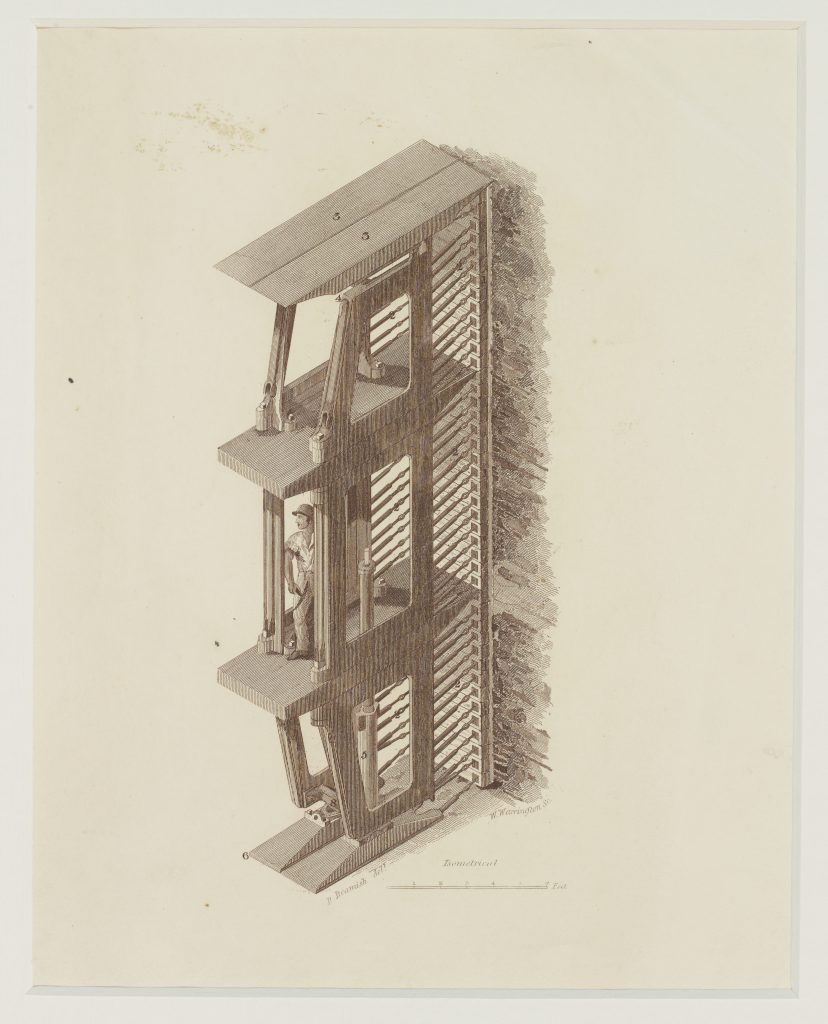This engraving was done by William Warrington, who worked closely with the Thames Tunnel Company both as an engraver and printer of some of the tunnel guide books. It is most likely a copperplate engraving, and reproduces a drawing done by Richard Beamish, one of Brunel’s engineers, which can be seen here. Both pieces feature one of the twelve iron frames that made up the tunnelling shield, and include a miner in the middle compartment. Facing the earth ahead of the tunnel are the series of poling boards, which were removed piece-by-piece to dig before advancing the entire shield.
In Beamish’s Memoir of the Life of Sir Marc Isambard Brunel (1862, pp.219 – 221), he includes a sketch of this same engraving and describes it as follows:
On the right is the representation of a portion of the ground in front. Against the ground the poling boards supported in place by the poling screws, resting or abutting against the cast-iron frames. On the top the top staves, at the bottom the shoes attached to legs…The frame will be seen to have been divided into three compartments or cells, each division being 3 feet broad and 21 feet 4 inches high; the 12 frames forming therefore together 36 cells, in which the miners worked independently of one another.
As an engraving, we know that the intention behind this illustration was to promote and publicise the tunnel. This particular engraving appears in several of the Tunnel guide books titled An explanation of the works of the tunnel under the Thames from Rotherhithe to Wapping, printed throughout the 1830s and 40s by Warrington. These described in some detail the way in which the Tunnel project was carried out—and include engravings of the shaft, miners, brickwork, and of course shield.
By this time, technical drawings had become a well-established method of communicating the design and functionality of engineering projects. However, they were just starting to be used as effective visual mediums for engaging a public audience, growing a project’s reputation, and even gathering financial support. The very fact that a drawing (LDBRU:2017.3 (a)) was transformed into this engraving shows that Brunel and his team understood the importance of publicising the tunnel.
While technical pieces for the workplace included specific details and annotations to bring the design to reality, pieces like this one were far more visually concerned to help the audience understand. In this image, for instance, a bar with foot markings for scale is included.
By nature, the Thames Tunnel project was already somewhat of a public spectacle. The series of watercolours and engravings associated with the project demonstrate the extent to which Brunel and the Tunnel Company aimed to capitalise on this spectacle and ultimately ensure the Tunnel’s success, financial and otherwise.
This engraving, together with its illustrated counterpart, show clearly that many hands were often involved in a single image of the Thames Tunnel. Looking at the diaries of one of Brunel’s employees, Gilbert Blount, Tunnel Superintendent from 1840-42, we know that drawings were often revised, modified, and transferred to other mediums for different uses. Engineers, draughtsmen, engravers, and many more played their part in almost all of the images associated with the project — many of which were integral to the eventual Tunnel’s success.
If you’d like a print of the artwork displayed above, you can purchase one from the ArtUK online shop.

